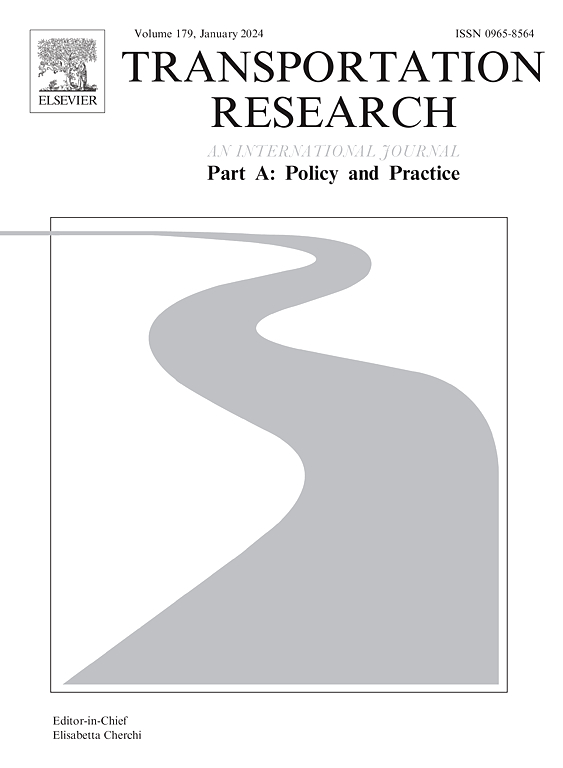Development and safety evaluation of an adaptive personalized speed guidance system for on-ramp merging in highway service areas
IF 6.3
1区 工程技术
Q1 ECONOMICS
Transportation Research Part A-Policy and Practice
Pub Date : 2024-10-25
DOI:10.1016/j.tra.2024.104296
引用次数: 0
Abstract
As autonomous driving and Vehicle-to-Everything (V2X) technologies evolve, the efficiency and safety of ramp merging in the highway service areas have become increasing critical. This study introduces a closed-loop feedback speed guidance system that accommodates individual driving styles, aiming to optimize merging behaviour, reduce traffic accidents, and enhance total traffic efficiency. The system dynamically adjusts the merging vehicle speeds by continuously monitoring their speed and location with variable steps to promote smoother merging. Moreover, this research also involves collecting naturalistic driving data from ramp merging scenarios, using the K-means clustering and point estimation method to recognize and analyse driving style characteristics, and integrating these styles into the developed closed-loop feedback speed guidance system. This approach results in personalized speed guidance curves tailored to different driving styles, facilitating more efficient mering. Additionally, the study conducts a Safety of the Intended Functionality (SOTIF) evaluation of this system using the System-Theoretic Process Analysis (STPA) method, which helps identify potential security risks and develop appropriate mitigation strategies to ensure the system’s safe and stable operation. The simulation results confirm that this innovative dynamic speed guidance system substantially improves traffic safety and efficiency in ramp merging areas.
高速公路服务区匝道并线自适应个性化速度引导系统的开发与安全评估
随着自动驾驶和车对物(V2X)技术的发展,高速公路服务区匝道并线的效率和安全性变得越来越重要。本研究介绍了一种适应个人驾驶风格的闭环反馈速度引导系统,旨在优化并线行为、减少交通事故并提高总体交通效率。该系统通过持续监测并线车辆的速度和位置,以可变的步骤动态调整并线车辆的速度,从而促进更顺畅的并线。此外,这项研究还包括收集匝道并线场景中的自然驾驶数据,使用 K-means 聚类和点估计方法识别和分析驾驶风格特征,并将这些风格特征整合到所开发的闭环反馈速度引导系统中。这种方法可根据不同的驾驶风格生成个性化的速度引导曲线,从而提高驾驶效率。此外,该研究还采用系统理论过程分析(STPA)方法对该系统进行了预期功能安全(SOTIF)评估,以帮助识别潜在的安全风险并制定适当的缓解策略,确保系统安全稳定地运行。仿真结果证实,这一创新的动态速度引导系统大大提高了匝道合流区的交通安全和效率。
本文章由计算机程序翻译,如有差异,请以英文原文为准。
求助全文
约1分钟内获得全文
求助全文
来源期刊
CiteScore
13.20
自引率
7.80%
发文量
257
审稿时长
9.8 months
期刊介绍:
Transportation Research: Part A contains papers of general interest in all passenger and freight transportation modes: policy analysis, formulation and evaluation; planning; interaction with the political, socioeconomic and physical environment; design, management and evaluation of transportation systems. Topics are approached from any discipline or perspective: economics, engineering, sociology, psychology, etc. Case studies, survey and expository papers are included, as are articles which contribute to unification of the field, or to an understanding of the comparative aspects of different systems. Papers which assess the scope for technological innovation within a social or political framework are also published. The journal is international, and places equal emphasis on the problems of industrialized and non-industrialized regions.
Part A''s aims and scope are complementary to Transportation Research Part B: Methodological, Part C: Emerging Technologies and Part D: Transport and Environment. Part E: Logistics and Transportation Review. Part F: Traffic Psychology and Behaviour. The complete set forms the most cohesive and comprehensive reference of current research in transportation science.

 求助内容:
求助内容: 应助结果提醒方式:
应助结果提醒方式:


